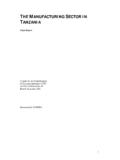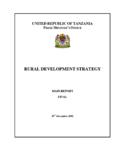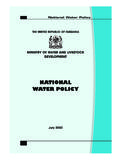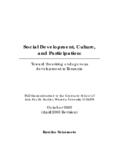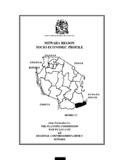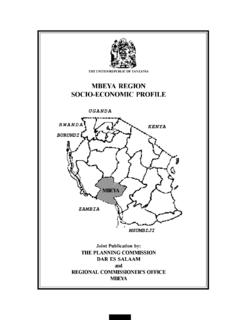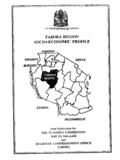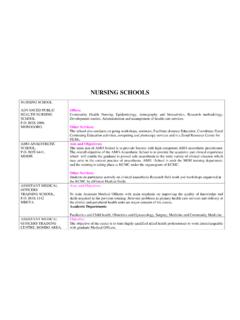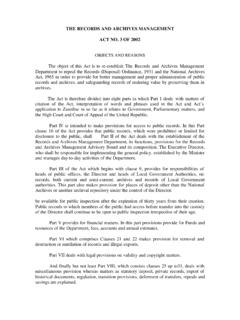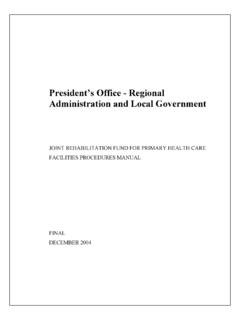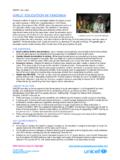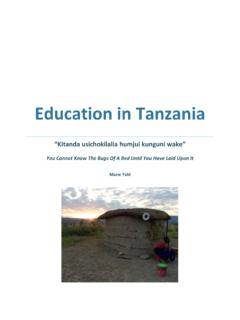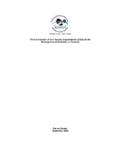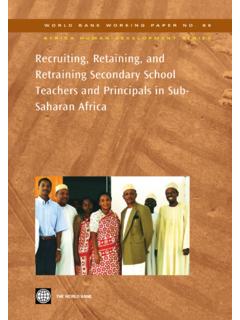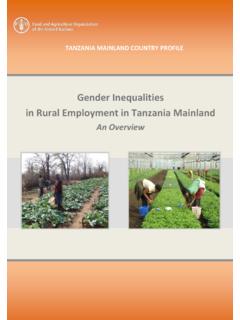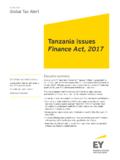Transcription of THE STATE OF TANZANIA’S SOCIAL SECTOR IN …
1 ECONOMIC AND SOCIAL RESEARCH FOUNDATION (ESRF). THE STATE OF tanzania 'S SOCIAL SECTOR IN. THE development context . By Prof. Samuel M. Wangwe and Dennis C. Rweyemamu Economic and SOCIAL Research Foundation (ESRF). Dar es Salaam Paper Presented During the CSSC Stakeholders Consultation in Bagamoyo, tanzania . November 2 nd, 2001. CONTENTS. INTRODUCTION ..3. EVOLUTION OF THE SOCIAL SECTORS IN tanzania ..3. Independence to the Early The Crises Era (1980s) ..5. TRENDS IN SOCIAL SECTORS IN THE 1990S ..6. Education ..7. Water and Sanitation ..12. HIV/AIDS Situation in KEY POLICY ISSUES .. 15. VISION AND M ISSION FOR THE NEXT T EN YEARS ..17. CONCLUSION AND BIBLIOGRAPHY .. 20. ---------------------------------------- ---------------------------------------- ---------------------------------------- ---------------------------------------- ------------- 2. The STATE of tanzania 's SOCIAL SECTOR in the development context Introduction The Government has a long enduring history of progress in the SOCIAL SECTOR , and a recognition that the country's development depends on the welfare of the citizenry.
2 From independence, delivery of a wide range of SOCIAL services has been considered as the government's responsibility and policy makers have sought to extend health, education, water and other SOCIAL services to the largely rural population of the country. Given the low-income levels of most Tanzanians, the government has provided services at no direct charge. Bilateral and multilateral donors have played an important role in the development of tanzania 's SOCIAL service infrastructure. A significant part of the capital for construction of service delivery points (dispensaries, health centres, primary schools and water systems) has come from external sources. In addition, some basic inputs such as essential drugs for rural health units and primary school textbooks have been provided by donor agencies. Both short and long-term technical assistance has been offered as managerial and technical support for SOCIAL services.
3 Non-governmental organizations particularly churches, have also contributed to the development of SOCIAL services in tanzania . For example, religious missions have supplemented government services with hospitals, dispensaries and schools in many parts of the country. Through the efforts of the government, donors and non-governmental organizations, significant strides were made in the SOCIAL sectors in the 1960s and 1970s. However, systems of SOCIAL service delivery that worked well in those early years were eroded in the 1980s and 1990s. This paper assesses the STATE of tanzania 's SOCIAL SECTOR in the context of development . It summarizes background information on conditions in the SOCIAL SECTOR within a historical context , reviews trends during the last decade, identifies key policy issues and their implications on key sectors, projects the future of the tanzania SOCIAL SECTOR and finally outlines areas that need intervention by development actors including churches.
4 Evolution of the SOCIAL Sectors in tanzania . This section describes the two earlier phases that characterized the supply of SOCIAL services in tanzania after independence. Independence to the Early 1980s At independence in 1961, tanzania inherited a colonial economic and public SECTOR structure. The country declared war on the nation's three archenemies; poverty, ignorance and diseases. At that time, the health system consisted of a few hospitals and private doctors in urban areas, and religious mission services and traditional healers in rural areas. The education system was stratified by racial categories (African, Asian and White), and the quality and accessibility of African schools were relatively poor. In the water SECTOR , most households (particularly rural) obtained water from natural sources. ---------------------------------------- ---------------------------------------- ---------------------------------------- ---------------------------------------- ------------- 3.
5 The STATE of tanzania 's SOCIAL SECTOR in the development context Recognizing fundamental inadequacies in the colonial system, and the vast needs of the population and the economy, the government sought to increase access to basic health, education and other SOCIAL services. Much of this was done with the help of bilateral donors willing to assist the newly independent country. The government's approach was to provide both basic and complex SOCIAL services to the full population, financing the services using tax revenues and donor support. Hence, the services were provided at no charges to the users. This general approach was interpreted within each SECTOR . Education The government was the primary provider of education services from primary through secondary, tertiary and vocational. Private and missionary schools were nationalized. Primary education was to be universally available, compulsory and affordable to the poorest households.
6 The curriculum and structure was oriented to rural life. The government tried to increase the equity of admission into the limited secondary schools through a quota system that gave preferential treatment to certain disadvantaged groups ( children from disadvantaged districts, girls ). Expansion of the education system was very rapid. Both the enrolees in primary schools and the number of education SECTOR workers increased by nearly four -fold during the 1970s. The majority of the primary schools now in operation were constructed during the 1970s, allowing each village to have its own primary school (URT, 1994). Most of the teacher training colleges now in operation were also opened during that period. Secondary school enrolments expanded at a much lower pace. This was due to deliberate rationing of secondary schooling as part of the governments effort to attain universal literacy and co-ordinate outputs from the educational system with the nation's manpower requirements.
7 Health The government took the responsibility for meeting the population's health service needs. Much of the private medical SECTOR was outlawed or nationalized. Services were made available at no charges to patients and were mainly directed towards the rural areas and towards basic health needs, as defined under Primary Health Care. This included family planning services integrated with maternal and child health. At the base of the pyramid and close to the village were rural dispensaries and health centres, while at the apex were consultant hospitals in large cities. The country tried to invest to attain self-sufficiency in all types of medical and paramedical personnel. The number of government operated rural health centres more than tripled between 1969 and 1978, and the number of dispensaries doubled. Most of the institutions currently training health personnel were opened during that period, and large numbers of rural medical aides, medical assistants, medical officers and nurses were trained and deployed to the rural areas.
8 As a result, the number of doctors increased more than three-folds and the number of medical assistants, rural medical aides, and health assistants increased by a factor of 10. This ---------------------------------------- ---------------------------------------- ---------------------------------------- ---------------------------------------- ------------- 4. The STATE of tanzania 's SOCIAL SECTOR in the development context expansion allowed about 90 percent of the population to be within 10 kilometres of a health facility, and nearly three-quarter to be within 5 kilometres of public health services (URT, 1994). Water The government instituted a policy of free water supply in the rural areas, in which users were not required to pay for services provided. The aim was to provide the rural population with clean, potable, dependable water supplies within 400 meters of the households. All water supply investments were financed by the government with substantial material and technical assistance from donor agencies.
9 Construction of water systems was based on Regional Water Master Plans which typically projected water system construction and the optimal domestic and agricultural use of all water resources over a 20-year time horizon. Water systems expanded greatly during the 1970s. Under the Regional Water Master Plans . donor-financed blueprints for improved water schemes were created in nearly all regions, and large-scale construction was initiated. The proportion of the population with access to improved water sources increased from 12 to 47 percent. As the water SECTOR picked up momentum, similar centrally planned activities were initiated to expand access to sanitary facilities, and in 1973 the government introduced the latrinization campaign, which required households to have and use a latrine. The Crises Era (1980s). The impressive investments and accomplishments of the 1970s could not be sustained through the 1980s.
10 The government encountered difficulties in financing and managing the SOCIAL services that had been put in place and at the same time the expectations of the population increased. By the end of the decade (1980s), the system that had promised rapid improvement in human welfare, failed to meet its ambitious coverage targets, and progress towards improved outcomes was lagging. Problems that emerged in the delivery of SOCIAL services can be grouped into two categories; supply-side conditions and demand side conditions. Supply -Side Conditions First, the recurrent cost burden following large capital investments in health, education and water services, and training of large numbers of personnel was enormous. While donors had been willing and able to finance much of the capital costs of developing the infrastructure, financing of the recurrent costs was largely left to the Tanzanian government, which in turn depended on too small a tax base.
